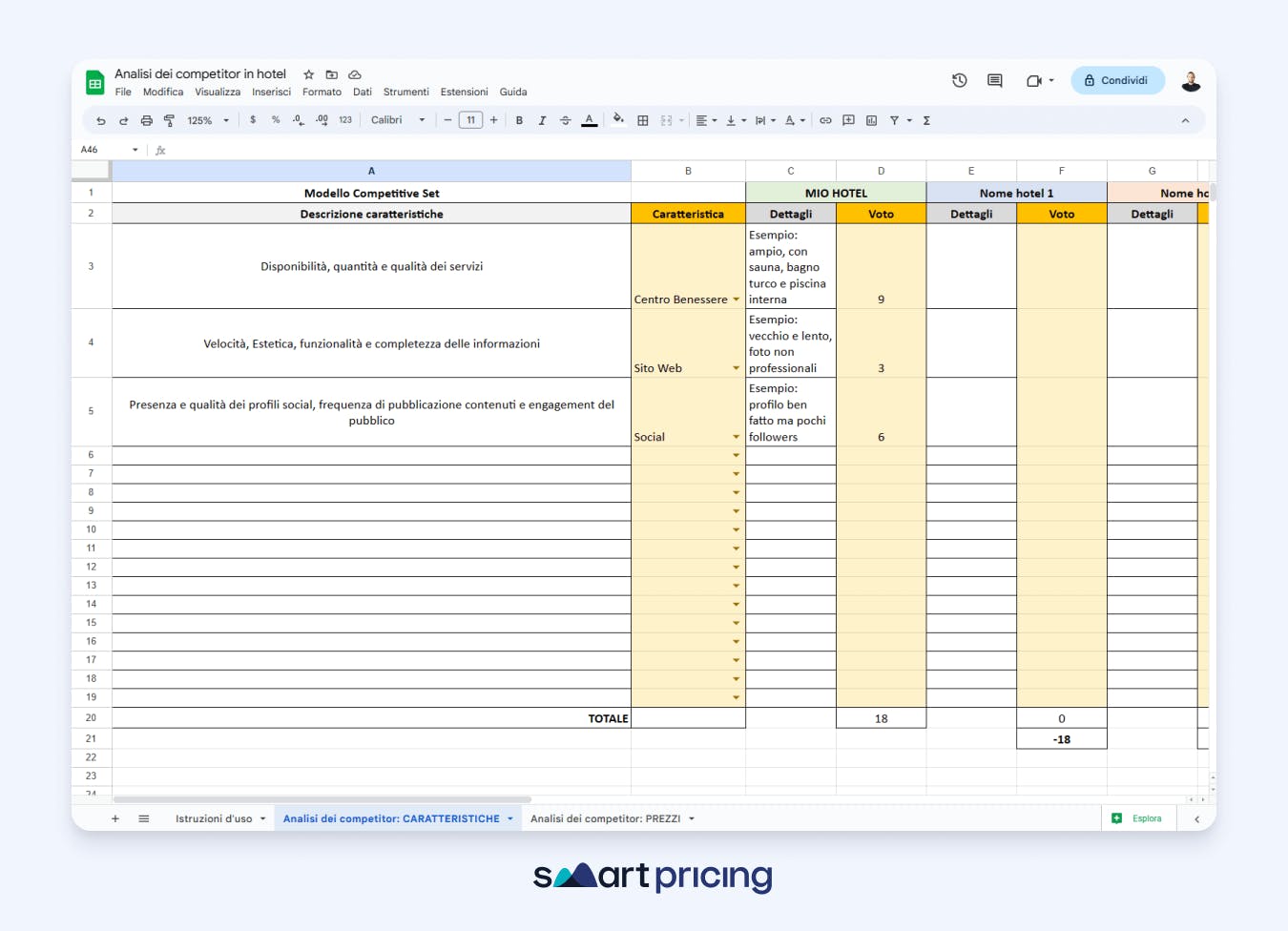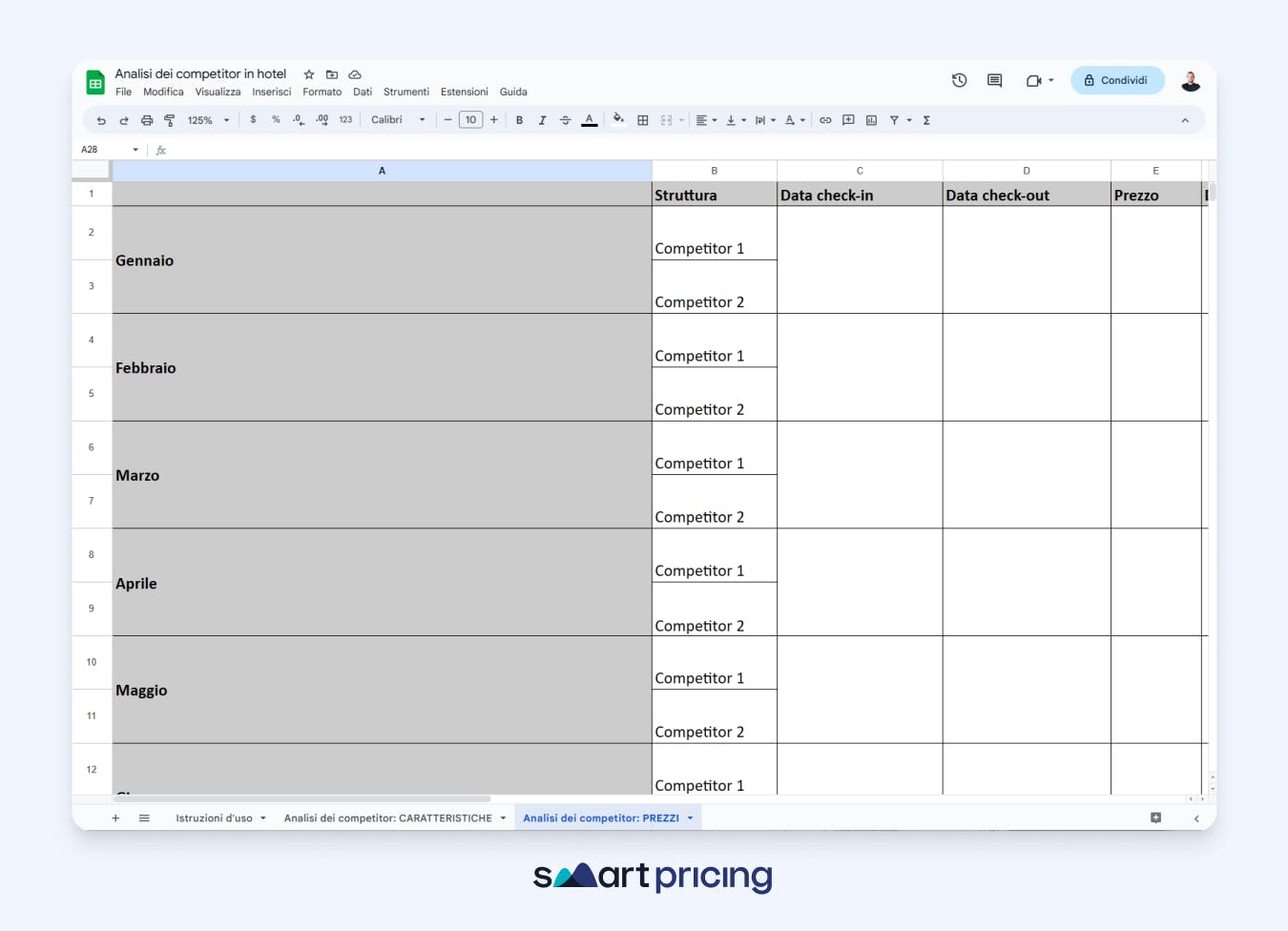Competitive set for hotels: what is it and why is it important?
Analyzing competitors is useful only if you know which accommodations to compare yourself with. In this article, you will discover how to identify your direct competitors and how to compile your Competitive Set.

Have you already defined a list of your competing accommodations and know exactly how you rank compared to them? If you have never done it or want to check if you have correctly set up your competitor analysis, now is the time!
Comparing yourself with your reference market is essential to correctly classify the performance indicators (KPIs) and use them to grow your business.
The best tool for hotel benchmarking is the Competitive Set (or Comp Set), the only one able to provide you with the necessary context to measure your performance against that of similar hotels in the market.
For example, Comp Set analysis could reveal the potential for a higher ADR and better occupancy.
What is the Competitive Set?
The Comp Set is a group of hotels (usually between 3 and 5, maximum 10) that can be considered your direct competitors. In other words, those accommodations with which potential customers compare you during their search.
Direct competitors have a comparable positioning to yours and present similarities in the following areas:
- Location: usually, they are the closest hotels to you, but they may also be further away.
- Price level.
- Number of rooms.
- Room categories
- Type of guests
- Reviews
- Services and facilities
In our Excel file for competitor analysis, you will find a ready-to-use template to easily create an overview of your competition.

The Competitive Set does not have to be just one: if your accommodation targets different market segments, it may be useful to define and monitor a separate set of competitors for each segment.
For example, a hotel offering meeting rooms might analyze both a Comp Set of competitors more oriented towards groups and businesses, and a separate Set of hotels with leisure clientele.
Why is the Comp Set important for competitive analysis?
Defining a Competitive Set allows you to determine your market positioning precisely and organize accordingly, for example by developing a truly competitive pricing strategy.
Furthermore, the Comp Set is an important source of information for your marketing actions: only by closely studying the hotels with which travelers compare you can you find significant insights to translate into an effective strategy that convinces potential guests to choose you.
How to build your Comp Set
To create your custom Comp Set, you need to follow these three steps:
- Analyze your offer
- Search for accommodations present in your market
- Narrow the list by isolating only relevant competitors
The first step in selecting a Comp Set is to make sure you know exactly the market positioning of your accommodation.
We suggest starting by listing the main features and advantages of your hotel, such as:
- ADR
- Guest reviews
- Design
- Meeting rooms
- Star rating
- Food & Beverage offerings
- Services (Spa, pool, gym, etc.)
- Pet policies
- Room types
- Loyalty program or discounts
- Proximity to major attractions
The next step is to search for hotels in your area that have similar sizes and offer similar services to yours.
Where do you find your competitors?
You can start the search on OTAs by filtering for star category or rating, thereby obtaining an initial list. By scrolling through this list, you then compare the offer of each hotel with yours and decide if it is a direct competitor or not.
At this stage, try to put yourself in the shoes of your potential guests!
For example, imagine you are a business traveler. Which property in the area attracts you the most? What features would you prioritize: offers, breakfast included, or proximity to your company headquarters?
Take the necessary time to do this research and, if needed, assign a potential competitor to each member of your team, involving everyone in the evaluation.
Who is really part of your competitive set?
Here are some key points to consider to reach the final list of competitors in your Competitive Set:
Location
Hotels that are in the immediate vicinity are usually also your main competitors because they are close to the same landmarks or attractions that bring travelers to your area.
We recommend including in your benchmarking both competitors located in the same area and offering your same services as well as properties that are similar to you but characterized by a different offer or market positioning.
For example, consider special activities or nearby tourist attractions, as well as commercial businesses, sports and entertainment offerings, or geographical features: if your property advertises a breathtaking view of the sea or mountains, look for hotels that offer the same.
Services
Depending on the type, each guest will look for different services. Your direct competitors target the same customer segments as you, whether they are leisure or business travelers, families, couples, or groups.
This attention will necessarily be reflected in their services as well. This is why it is sufficient to evaluate their offers related to restaurant, bar, meeting rooms, pool, or shuttle service to draw important conclusions about the type of clientele of your competitors.
Room quality
Travelers also compare hotels based on different room categories and bed configurations.
Services in Superior rooms translate into higher perceived value of the accommodation.
Reviews
Another important factor to consider is the online reputation of your competitors and the perceived value that can be gleaned from reviews. Generally, when compiling your Competitive Set, you should consider the accommodations that have the same rating category.
On online booking portals, accommodations can be filtered based on stars or similar ratings. Trying to identify which comparable hotels are rated slightly better than yours is the best method to find out what they offer more than you.
In this way, you will also know what guests base their decision on when booking with you or your competitors.
At the end of the search, you will be able to reduce your initial list to the top four to ten competitors that have the most overlap with your offer in as many categories as possible.

Have you chosen your list of competitors for the Comp set well?
After engaging in your research of direct competitors, it is always worth double-checking and asking yourself 'have I really chosen my real competitors?'.
It's easy to fall into the temptation of grouping your hotel into a sophisticated Comp Set, along with establishments that offer superior services or are closer to the main attractions in the area than you are.
Remember that compiling an incorrect Competitive Set makes the value of the benchmarking data derived from it unreliable!
Choosing the wrong hotels is not the only factor to pay attention to: your competition is continually evolving and therefore the Competitive Set should never be final and static.
The Competitive Set analysis is an essential component of price management: it allows you to know the value of your hotel compared to that of your competitors, to determine prices accordingly, and to regularly adjust them to changing market conditions and competitor activity.
Did you know that Smartpricing also does this? Thanks to artificial intelligence and machine learning, the software constantly analyzes and cross-references the internal data of your property and that of your target market (including competitors), helping you find the best price for your rooms.
Once the price is calculated, it then automatically updates it on all sales channels, relieving you of a concern and saving you valuable time!
